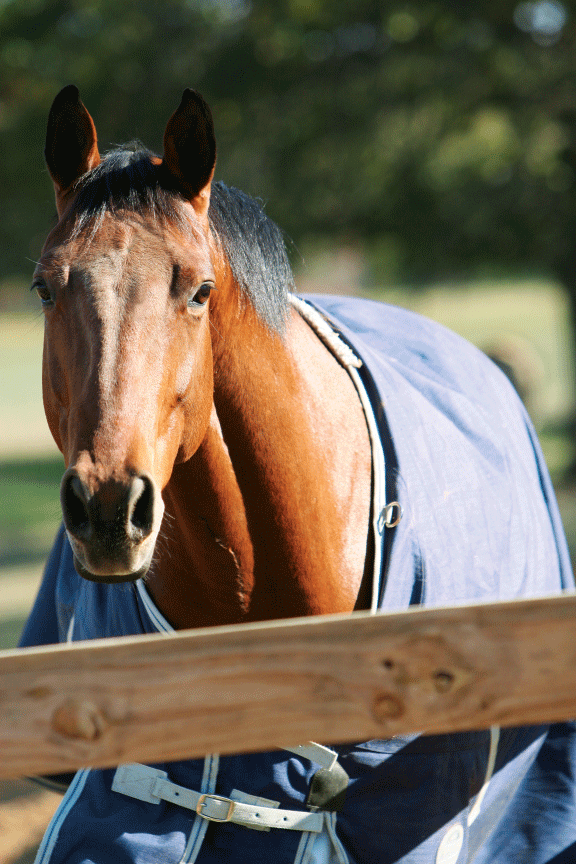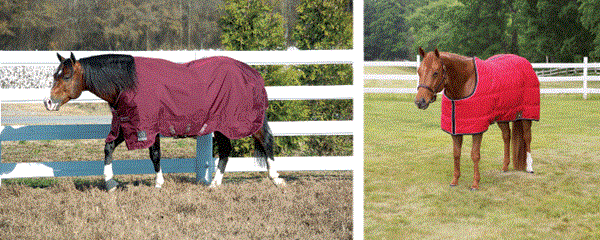There’s no escaping the fact that money is tight for most of us. The coming winter will have its own set of financial demands on the average budget. Then, there are the price increases in hay, grain, vet care, farrier visits—all things arguably more important to general equine welfare than keeping them in clothing.

But don’t get in a rush to nix quality blankets and other horsewear from your budget—especially if you show, fit, or sell horses; live in a harsh climate; or care for a geriatric or special-needs equine. Blankets provide warmth, protection from the elements, armor from a mouthy barnmate, and polish to a fantastic show coat. A basic blanket can protect an ill horse from drafts, or keep mud from bringing your pre-ride routine to a crawl.
The decision to buy a blanket is relatively easy, but shopping for and selecting the best blanket for your horse’s needs can be a different story. At risk is your budget, as buying the wrong blanket can be an expensive mistake. Not only do retailers offer a potentially overwhelming number of choices, the horsewear trade employs words that, unless decoded, may make your head spin.
Our blanket-buyer’s guide will help you sort things out.

FEATURE FACTORS
As you read in-store product literature or catalog copy, you’ll encounter terms for various blanket features. Some features may be just right for your particular horse, while others may not. Here’s what some of these common terms mean:
European cut. Suits slim, long-bodied horses, such as modern hunters. Smaller neck openings and straight in profile from withers to tail than standard cut. Measured in 3-inch increments. (See “Finding the Perfect Fit,” on page 53.)
Standard cut. Designed for wider, stock-type body profiles. Often shaped for curvy, muscular shoulders and hips. Measured in 2-inch increments (sidebar on page 53).
Closed front. Continuous fabric across the horse’s chest, with no adjustable closures. Less to wear, tear, or break, but you sacrifice the greatest point of adjustability.
Open front. Chest-front section opens and closes via buckles or snaps. Snaps are more convenient than buckles, and both accommodate growing horses. Tip: Open-front blankets with a single closure are for supervised wear only, such as when you’re walking a horse to cool him out. If a horse rips out the single closure system while turned out or left in a stall, there’s nothing else to hold the blanket in place.
Shoulder darts. Sewn-in construction that affords shoulder movement and eases shoulder rubs. Tip: Rubs will only be eliminated if the dart is above the point of shoulder.
Drop. Standard blankets drop a couple inches below the belly. Extra-long drops add inches of coverage, which may be desirable if you want more coverage of the forearms and lower hindquarters.
Shaped withers. Construction style, either cut-back or with added fabric shaping, meant to provide pressure relief over the top of prominent withers.
Back seam. Results when a blanket is seamed down the middle of the back. Tip: Avoid this if you’re buying a turnout blanket that will be worn outdoors. Taped seams help prevent leaks, but if a blanket is punctured by a thread stitch, there’s a greater potential for leakage, particularly as the blanket ages. ➞
Belly band. Under-belly closure system that uses a wide band of fabric. Belly-band styles are popular in cold climates. The added fabric serves as a blanket-weight booster. By trapping heat lost through the belly, a blanket’s performance will increase significantly. Caveat: If your horse tends to rip blankets with his teeth, he may be able to make short work of reaching back and tearing a belly-band closure apart.
Tail cover. Fabric that covers the top several inches of the horse’s tail. When turned out, horses will instinctively turn their tails to a strong wind or driving rain. A tail cover prevents drafts from making their way under the blanket as winds blow the fabric.
Attached neck cover. Sewn-in extra fabric that covers the neck. Eliminates the need for a separate neck cover, while also preventing any gap between the garments. Caveat: Hoisting a blanket with a neck cover over your horse requires some muscle on your part—it’s like slipcovering a sofa (one that’s much higher than furniture, and could try to move as well). Useful for limited seasons. When it’s too hot for a neck cover, the entire blanket will end up in storage.

MATERIAL MATTERS
A blanket’s materials greatly contribute to its longevity. Keep the following in mind as you shop:
Plastic attachments will become brittle over time, breaking easily. For longevity, opt for metal fittings.
Hook-and-loop fastener materials have a much shorter usefulness than nylon. Attachments that depend on hook-and-loop fasteners will require replacement long before the nylon wears out. (Many different brands of fasteners available; the best-known is Velcro™.)
Elastic leg straps accommodate do-it-yourself repairs if they’re removable. Makers of lower-cost blankets often stitch one end to cut their materials costs, making replacement more difficult.
Denier is a “numbers” issue in more ways than one. Technically, the term refers to a unit of measurement of linear density of textile fiber mass. (See “Constructive Lingo” on page 53 for more.) What you need to know: The higher the denier number, the stronger the fabric; the higher the denier, the more expensive the blanket. Tip: Spend your dinero on denier, buying the highest quality you can afford. The blanket will last longer and provide greater protection than a lower-denier blanket of similar styling.
Quilting looks great on a bedspread, but for horse blankets, it’s best suited for indoor stable blankets or underlayers. Stitches = holes = leaks.
Taped seams add labor dollars to the cost of a blanket, but provide a layer of protection against leaking seams and stitching holes.
Nylon-based linings are like an extra grooming every day, distributing oils throughout a horse’s coat without absorbing them as cotton-based linings do.
Lightweight layers usually can be laundered at home in a large washing machine. Single, heavyweight blankets require professional laundering, or a trip to a coin-op laundry that permits stinky, hair-encrusted horse blankets. Those are few and far between. Tip: Save on heavy-blanket laundry bills by layering a lightweight sheet or blanket over the top. It’ll capture much of the grime, and you can wash it yourself. Plus, you can make repairs to lightweight items at home with a standard sewing machine—another way to save dollars.
Natural wool fabrics offer great insulation, but aren’t machine washable, and they waterlog quickly in wet weather.
Satin is a poor choice for unattended blankets, as its weaving technique minimizes the number of times fibers interlace in the material. Its soft, silky texture is perfect for coolers, but not for stable blankets.
Professional cleaning is a good investment, at least at the end of blanket season. If not removed prior to storage, manure, urine, mud, and molding hay can damage your blanket.
CONSTRUCTIVE LINGO
Denier.
Analogous to thread count in bed sheets. Blanket linings range from 70 to 150 denier. Outer layers start at 300, and climb to a heavy, iron-wearing 2400.
Cordura®. Synthetic nylon fabric that’s highly resistant to abrasion, fungi, mold, mildew, and rot. Heat setting and special coatings add such qualities as water resistance or proofing, and abrasion and tear resistances.
Ballistic nylon. A synthetic fabric designed to withstand a severe beating. It’s heavier in weight than Cordura®, with the weights typically starting at 1050 denier.
Rip-stop nylon. Lightweight nylon fabric woven in a special crosshatch pattern that resists ripping and tearing. It’s used in applications where lightweight, strong fabric is needed. Provides wind and water protection, but no insulation.
Hollofil®, hollow fiberfill, fiberfill, polyfill insulation. All used to denote olefin, a polyester fiber that resists water, is machine washable, and offers a high insulation value at a light weight. Provides uniform warmth and firm consistency that maintains its shape.

BONUS TIPS
- Don’t pack away your fly sheet when summer ends. Layer it under a blanket to create air pockets that will trap your horse’s body heat. By draping it over other blankets, particularly fleece, you’ll prevent shavings from sticking, and provide a sacrificial layer for the hundreds of things blankets get caught on.
- Layer, layer, layer! You might have a sheet and a lightweight blanket, but, combine them, and you have the equivalent of a medium-weight blanket.
- If you’re tired of taking blankets to the repair shop to have nylon leg straps reattached yet again, consider having D-rings sewn on instead. Replaceable elastic leg straps, around $3 each, become a DIY repair.
- If possible, don’t measure your horse for a blanket by yourself. (See “Finding the Perfect Fit” on page 53.) On most horses, it’s difficult for one person to reach from the center of a horse’s chest to the middle of the tail. For an accurate, straight measurement, recruit a friend to hold the other end of the cloth tape.
- If you have safety concerns in using a standard hood (hoods can slip down, covering a horse’s eyes, and the eyeholes can catch on things), consider a neck cover, either alone, or layered over a snug, stretch-fabric hood.
- If you’re not picky about color, but need varied sizes, consider reserving a single size to a single color. (Example: Buy your size 78 blankets in red, and your size 82s in blue.) You can quickly grab the right size long after the size tags wear off.
- Horse height doesn’t correlate to blanket size. Musculature of a horse’s shoulders and hips, as well as spring of the ribs, length of the topline, and where the particular blanket fits in your layering system, will affect blanket measurement.






